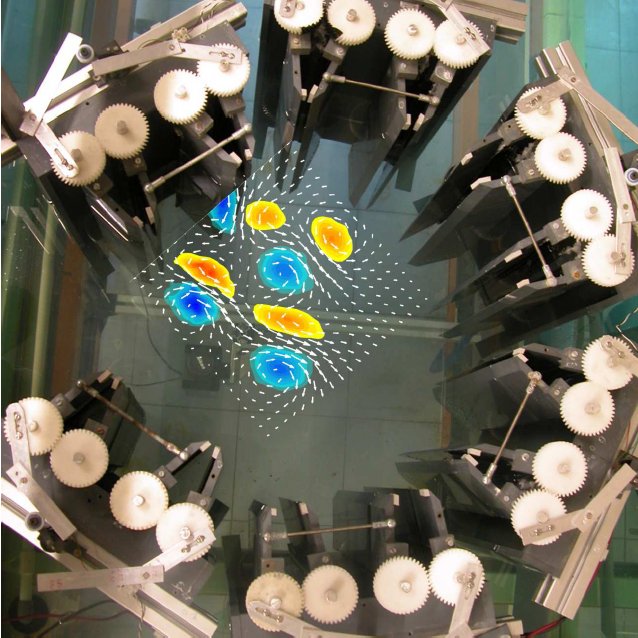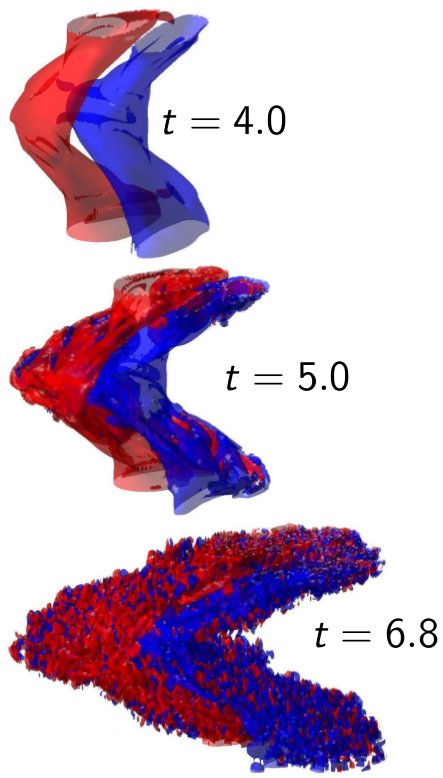From 2008 to 2011, I was a PhD student under the supervision of Paul Billant and Jean-Marc Chomaz at the LadHyX, the hydrodynamical lab of Ecole Polytechnique (France). You can download my PhD manuscript (it should also be here), defended November 21th 2011 (Ecole Polytechnique PhD thesis award 2012).

Top view of the experiment and PIV measurements.
During my thesis, dealing with turbulence in stratified fluids, we have characterized the statistics and dynamics of disordered and fully turbulent stratified flows. We have also studied the transition to turbulence of a simple flow in order to better understand the basic physical mechanisms involved in stratified turbulence.
Studies of stratified turbulence forced with columnar dipoles
A novel experiment of forced strongly stratified turbulence
We have set-up a novel experiment of continuously forced, stratified disordered flows. This set-up differs from previous experiments of stratified turbulence since the forcing consists in vertically invariant columnar vortex pairs generated intermittently. After an initial spontaneous three-dimensionalisation of the flow, a statistically stationary disordered state is reached.
For weak forcing, the horizontal flows corresponding to different layers are quasi two-dimensional and the structures are smooth suggesting that these experiments are in the viscosity affected stratified regime. In contrast, for strong forcing, we observe small scale structures superimposed on the large scale horizontal layers, indicating that these experiments approach the strongly stratified turbulent regime.
Numerical study of strongly stratified turbulence
The experimental results have been supported and extended by numerical simulations. The flow is forced similarly like in the experiments with coherent columnar dipoles. For the experimental parameters, numerical and experimental results are in good agreements. In particular, we observe when the buoyancy Reynolds number is increased a similar transition between a viscously affected regime and a strongly stratified nearly turbulent regime with overturning at small scales. When the buoyancy Reynolds number is further increased, strongly stratified turbulence is obtained.
Secondary instabilities on the zigzag instability

Iso-vorticity surfaces.
Onset of secondary instabilities
I have investigated by means of numerical simulations the dynamics at high Reynolds number of two counter-rotating vortices in a stratified fluid. We have demonstrated that two types of secondary instabilities develop simultaneously but in different regions of the dipole: a shear instability develops in the most bent region of the vortex cores whereas a gravitational instability develops in the middle between the two vortices.
Spectral analysis of the transition to turbulence
This transition to turbulence has been further investigated by a spectral analysis. We have shown that the characteristic length scale of the Kelvin-Helmholtz billows is of the order of the buoyancy scale. Both instabilities lead to a transition to turbulence which exhibits anisotropic spectra similar to those associated to fully developed strongly stratified turbulence. For the first time, a return to isotropy is observed for scales smaller than the Ozmidov length scale.
Kolmogorov laws for stratified turbulence
Following the Kolmogorov technique, an exact relation for a vector third-order moment J is derived for three-dimensional incompressible stably stratified turbulence under the Boussinesq approximation. An integration of the exact relation under this hypothesis leads to a generalized Kolmogorov law which depends on the intensity of anisotropy parameterized by a single coefficient. By using a scaling relation between large horizontal and vertical length scales we fix this coefficient and propose a unique law.